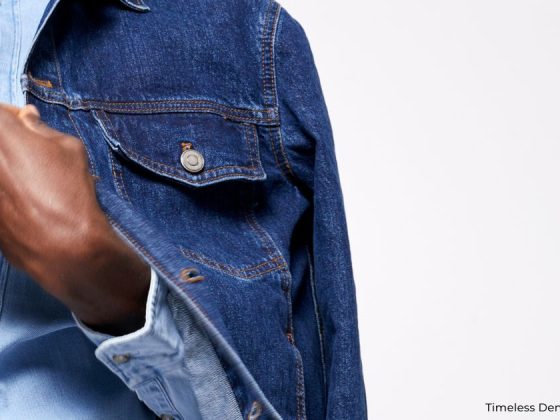Sustainability is no longer just a trend and has become a lifestyle standard. In 2025, men’s fashion is embracing materials that combine performance, comfort, and environmental responsibility. Among these, eco-fabrics men must try are leading the way, including hemp, recycled polyester, and bio-leather. Each fabric brings unique benefits to the modern man’s wardrobe, offering durability, refined texture, and reduced environmental impact while showing that style and sustainability can coexist.
Why Fabrics Matter in Men’s Fashion
The fabric of a garment does more than cover the body; it defines how it feels, moves, and endures. Every thread carries a narrative, from its origin to its performance under daily wear. As awareness of climate change and ethical production deepens, the conversation around men’s fashion has shifted beyond aesthetics. Today’s modern man isn’t just buying a shirt or a jacket; he’s investing in a material that reflects his values. The growing preference for responsibly sourced fabrics demonstrates that style and sustainability are no longer opposing ideals, but rather partners in innovation.

This shift has propelled materials like hemp, recycled polyester, and bio-leather into the spotlight. Hemp is celebrated for its durability, breathability, and minimal water usage, making it a natural alternative to traditional cotton. Recycled polyester gives plastic waste a second life, transforming discarded bottles into lightweight, resilient fabrics perfect for active lifestyles. Bio-leather, derived from plant-based or lab-grown sources, offers the elegance of genuine leather without the environmental cost. Together, these textiles prove that conscious fashion doesn’t require sacrificing sophistication. By embracing these materials, men can redefine what it means to dress well, choosing fabrics that are as forward-thinking as the people who wear them.
3 Eco-Fabrics Men Must Try for Stylish 2025 Wardrobes
Hemp
Hemp is having a major comeback. Known for its strength, breathability, and minimal environmental impact, hemp has become a go-to fabric for men who value functionality and natural comfort. It grows quickly with little need for pesticides or irrigation, making it a sustainable alternative to traditional cotton.
Why Hemp Works for Men’s Clothing
Hemp naturally complements classic masculine silhouettes. It adds texture and depth to pieces like chore jackets, relaxed trousers, and structured shirts. The fabric’s durability makes it ideal for men who lead active lives or prefer clothes that hold their shape through years of wear. Unlike synthetic blends, hemp becomes softer with time, developing a lived-in character that reflects personal style.
Comfort and Performance
Modern hemp fabrics have shed their old reputation for being rough. With improved spinning and blending techniques, hemp garments now feel soft and breathable from the moment they are removed from the box. They wick moisture effectively, making them great for warmer climates or long travel days. The fabric’s natural resistance to odors is another bonus for men who value low-maintenance wear.
Styling Ideas
Pair a hemp overshirt with chinos for a relaxed yet polished weekend look. For summer, lightweight hemp shorts and a button-up create an effortless, breezy outfit. In cooler weather, hemp canvas jackets layered over a cotton tee offer both texture and warmth. When shopping, look for 100% hemp or hemp blends with natural fibers, such as linen or Tencel, for added softness and comfort.
Considerations
Hemp can wrinkle more easily than synthetic fabrics and may need light ironing or steaming. Some manufacturers blend it with other fibers to reduce wrinkling, though that can slightly lower its sustainability benefits. Still, hemp remains one of the most eco-friendly and stylish options for men’s clothing in 2025.
Recycled Polyester
Polyester has long been favored for its strength and versatility; however, its petroleum-based origins have raised environmental concerns. Enter recycled polyester, also known as rPET, which transforms discarded plastic bottles and textile waste into new, high-quality fabric. This innovation reduces landfill waste and minimizes reliance on virgin petroleum.
Why Men Are Choosing Recycled Polyester
Recycled polyester offers the performance men expect: quick-drying, wrinkle-resistant, and durable. It’s the fabric of choice for men who prioritize functionality without compromising style. Whether it’s for gym wear, travel jackets, or sleek outerwear, recycled polyester maintains its shape and texture over time.
Everyday Benefits
From moisture-wicking T-shirts to weatherproof parkas, recycled polyester is built for movement and modern living. It’s also easy to care for, which suits busy lifestyles. For men who travel frequently, recycled polyester pieces are lightweight and packable, making them perfect companions on the go.
Practical Shopping Tips
When selecting recycled polyester garments, look for labels that indicate a high percentage of recycled content. Some brands also offer textile-to-textile recycled polyester, which further enhances circularity by turning old clothes into new ones. Investing in these items supports a more sustainable fashion system.
What to Watch For
Recycled polyester still sheds microfibers during washing, so it’s best to use a laundry bag designed to catch them. Opt for gentle wash cycles and air drying whenever possible. These simple care habits can significantly reduce environmental impact and extend the life of the garment.
Bio-Leather
For decades, leather has symbolized timeless masculinity and sophistication. However, traditional leather production involves significant environmental costs. Bio-leather, also known as plant-based or lab-grown leather, provides a sustainable alternative that retains the luxurious look and feel men appreciate.
What Makes Bio-Leather Stand Out
Bio-leather is made from renewable sources, including mushroom mycelium, pineapple leaves, and lab-grown collagen. These materials mimic the texture and durability of traditional leather but require far fewer resources to produce. For men who want refined style with a clear conscience, bio-leather provides an ideal solution.
Style and Functionality
Bio-leather fits seamlessly into men’s wardrobes. It’s used in jackets, boots, belts, and bags that look and feel premium. A mushroom-based leather jacket can have the same supple feel as classic leather, yet it’s lighter and more breathable. Bio-leather accessories, like wallets or belts, pair effortlessly with both casual and formal outfits.
Care and Maintenance
Maintaining bio-leather is simple. Most pieces can be wiped clean with a damp cloth, and they don’t require conditioning as often as animal leather. However, as this material is still evolving, not all versions offer the same level of durability. Look for brands that specify their bio-leather type and provide a guarantee for long-lasting wear.
Choosing the Right Eco-Fabric
Selecting the right eco-friendly fabric involves more than just choosing what looks good. It involves understanding how each material performs, feels, and aligns with personal values. Each sustainable textile offers distinct advantages that cater to different lifestyles, climates, and preferences. Hemp, recycled polyester, and bio-leather are not interchangeable; they serve unique purposes that show how fashion can be both functional and responsible.

For comfort and breathability, hemp is an excellent choice. It is naturally antibacterial, lightweight, and moisture-wicking, making it ideal for warm or humid environments where staying cool is essential. For performance and durability, recycled polyester stands out. It is strong, wrinkle-resistant, and easy to maintain, perfect for men with active schedules or those who travel frequently. For timeless sophistication, bio-leather is a refined option. It replicates the luxurious texture of traditional leather while using eco-conscious sources such as mycelium or plant-based materials.
When shopping, it helps to look beyond the label. Check the fiber content, brand transparency, and production methods to ensure quality. Certifications such as GOTS (Global Organic Textile Standard) or OEKO-TEX indicate responsible sourcing and low-impact processing. Brands that provide take-back or recycling programs demonstrate a genuine commitment to circular fashion. Ultimately, investing in high-quality, sustainably made pieces creates a wardrobe that matures gracefully, rather than wearing out quickly, making it both stylish and environmentally sound in the long run.
Caring for Eco-Fabrics
Sustainable clothing stays truly sustainable only when it’s properly cared for. The longevity of eco-friendly fabrics depends on how they’re washed, dried, and stored. Proper maintenance helps preserve color, texture, and structure, ensuring that every piece continues to look and feel its best over time. It also reduces waste, as well-kept garments last longer and require fewer replacements. With just a little extra attention, it’s possible to extend the lifespan of your wardrobe while minimizing your environmental footprint.
Hemp: This fabric thrives on gentle care. Wash it in cold water with a mild, eco-friendly detergent to maintain its natural texture and prevent fading. Avoid harsh chemicals or bleach, as they can weaken the fibers. After washing, air-dry hemp garments in the shade to protect their color and shape. Over time, hemp softens beautifully without losing durability, making it one of the most low-maintenance yet resilient fabrics.
Recycled Polyester: Though durable, recycled polyester benefits from mindful washing practices. Use a gentle cycle with cold water and place items in a microfiber-catching bag to prevent synthetic fibers from entering waterways. Avoid high heat when drying, as it can damage the fabric and shorten its lifespan. Line drying or using the lowest dryer setting is best for maintaining elasticity and preserving the original form. Regular care ensures your performance wear remains smooth, strong, and eco-conscious.
Bio-Leather: This innovative material requires special handling to retain its refined appearance. Wipe it clean with a soft, slightly damp cloth, avoiding harsh cleaners and excessive water. Always store bio-leather items in a cool, dry place away from direct sunlight to prevent cracking or discoloration. Using a breathable dust bag or cotton cover can help preserve the finish and flexibility of the item.
Finally, minor repairs go a long way. Reinforcing a seam, mending a tear, or replacing a button not only saves money but also strengthens the sustainability cycle. Simple actions, such as re-stitching a pocket or patching a minor flaw, can add years to your favorite eco-friendly pieces, proving that true sustainability begins with how clothing is cared for and valued.
The Future of Men’s Sustainable Fashion
The momentum toward sustainability in men’s fashion will only grow stronger. More brands are investing in textile recycling and developing advanced bio-materials. The focus is shifting from short-term trends to long-term value, with consumers playing a crucial role by choosing quality over quantity.
Men’s fashion in 2025 is no longer about choosing between style and responsibility. It’s about merging the two. Hemp, recycled polyester, and bio-leather demonstrate that sustainability can be refined, comfortable, and perform exceptionally well. As more innovations emerge, the modern man’s wardrobe will continue to evolve, built on fabrics that are as intelligent and adaptable as the men who wear them.
Redefining Men’s Fashion with Purpose
Building an eco-friendly wardrobe is not about perfection. It’s about progress. A hemp overshirt, a recycled polyester jacket, or a bio-leather belt might seem like small steps, but together they redefine what modern men’s fashion stands for: style that respects both people and the planet.




